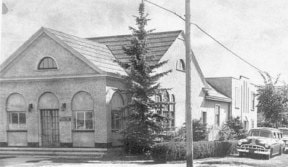Although looked upon by some for many decades as a nuisance and somewhat destructive part of our natural wilderness landscape, it was the sheer determination of the beaver family, who with their tenacious and superb engineering skills likely influenced the history of Canada more than any other animal.
The early Indians called the beaver the ‘sacred centre’ of the land, because they methodically create habitats for others mammals, fish, turtles, frogs, birds, and ducks. Beavers can and have changed the landscape by damming streams, and much of the flooded area that they create becomes wetlands. Many endangered and threatened animals rely on these wetlands for their survival.
While browsing through the delightful Crestomere/Sylvan Heights Heritage booklet I found this amazing account as written by the first hardy explorers and surveyors to travel across that rugged area to the west of Ponoka. Their description of the untouched wonders of nature that they encountered is a joy to read.
The earliest historic record of white men crossing this particular area is vividly contained in Captain John Palliser’s report in 1863. He was on a journey from Fort Edmonton to Rocky Mountain House, accompanied by his own man Foulds and two of the company’s, all having trained dogs like himself. It was a six-day journey, and the four days made through this immediate area are covered in this excerpt of his colourful diary.
Jan. 9: Having received my provisions from the store, consisting of pemmican, a little dried buffalo meat, as well a small stock of tea and sugar we started by crossing the river at 10 a.m. The track at once leaves the Saskatchewan, and does not meet it again until the mountain fort. After four miles along a track cut through dense thickets, we came to the White Mud Creek, on the west side of which there is a high conical hill of the same name; after passing which we get into more open country, forming a succession of limited openings, clothed with very rich pasturage in which the vetch grew with great luxuriance. This is a very common feature of the country round here. After making 17 miles, we halted for the night at the side of a gully that we had been following for some time.
Jan. 10: Soon after starting this morning we crossed Escapotte’s Creek, and here, as everywhere in the district, I observed the immense changes which are worked in the appearance of the country by beaver. Wherever there is a hollow in which water could collect, this industrious animal seems to have applied his instinctive ingenuity to create a lake. Some of these beaver’s dams are of extraordinary size, stretching for hundreds of yards, and sometimes rising six to eight feet high. Many parts of the track which is used in summer is cut through thickets with great trouble, and the manner in which the trail took advantage of every little opening, and then chose the shortest possible line when cutting had to be effected, was truly wonderful and amazing. As this was my first experience in really thickly wooded country, I soon got quite bewildered. On entering a long swamp, we suddenly came upon a party of travelers with horses and sleighs (made just like dog sleds, only larger), and found it to be Mr. Brazeau, the Borgeau of the Mountain House, who was on his way to Edmonton. After a few minutes of conversation each party proceeded on its way, with Mr. Brazeau expecting to reach Edmonton that night. He had been seven days on the journey, and informed that they had been living all the time on rabbits, which were in great numbers this year. When we halted for dinner at a clump of pines and poplars, I measured one of the latter (populous tremuloides) and found it to be the very unusual size of two feet in diameter. In the afternoon we traversed the Stones Indian Plain, which well deserves its name from being covered with boulders, which are rather rare in general in this district of the country. We felt the want of snow a good deal now, with many parts where the trail passed being quite bare; so much so that we set fire to the grass just to say that we had done so on this 10th day of January. After coming in sight of the Pigeon Hills, on the west side of which is the Wesleyan Mission Station under the care of Mr. Woolsey (whom I had met in Edmonton), we reached the ‘Bad Beaver Dam,’ near which we encamped for the night. This ‘Bad Beaver Dam,’ as it is called, is a succession of beaver dams, which form a chain more than a mile long, damming up very extensive swamps. The night was bitterly cold, so much so that we lighted two fires and lay between them to counteract the keen biting north wind, which continued to blow very hard, although the thermometer fell to 20 below zero.
Please watch for the final chapter of this historical encounter in next week’s edition of Reflections in your Ponoka News.
